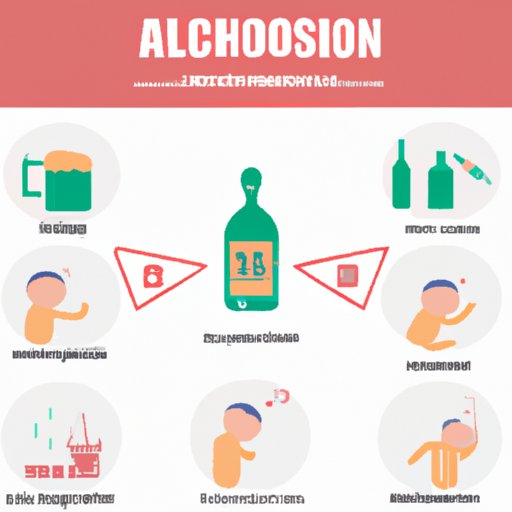
Introduction
It’s not uncommon for people who have consumed alcohol to experience nausea and vomiting. As many as 25 to 30% of heavy drinkers will experience vomiting due to alcohol consumption. Drinking in excess can lead to a whole host of unpleasant symptoms, including the stomach-churning feeling that often accompanies nausea and vomiting. In this article, we will explore why alcohol makes you throw up, how you can avoid this unpleasant experience, and what can be done to manage symptoms if it does happen.
The Science of Alcohol-Induced Vomiting
When you drink alcohol, it travels through your digestive system and is absorbed into the bloodstream. From there, it makes its way to the liver, where it is broken down and eliminated from the body. However, alcohol can irritate the lining of your stomach, which can cause nausea and vomiting. Additionally, alcohol slows down the digestive process, meaning that the food and liquid you consume will take longer to pass through your body. This can lead to the accumulation of alcohol in the system, further exacerbating the effects of nausea and vomiting.
Different types of alcohol can affect your body in different ways. For example, beer is carbonated, which can make it harder for your body to digest. Wine and other alcoholic drinks can contain tannins that can irritate the stomach lining. Spirits like whiskey, vodka, and gin are made with a higher percentage of alcohol, which can make them more potent and more likely to cause vomiting.
Drinking on an empty stomach can also exacerbate the effects of alcohol-induced vomiting. When you drink alcohol with food, the food can help absorb some of the toxins and protect your stomach lining. However, if you drink on an empty stomach, there’s nothing to absorb the alcohol, and it can quickly irritate the lining of your stomach.
Tips for Avoiding Alcohol-Related Nausea
If you’re prone to vomiting after drinking alcohol, there are some practical tips you can follow to limit your symptoms and avoid feeling sick. First and foremost, it’s essential to pace yourself when drinking. If you drink too much too quickly, it’s more likely to cause nausea and vomiting. Alternating alcoholic beverages with non-alcoholic drinks like water or soda can also help pace your drinking.
It’s also essential to choose your drinks carefully. Different types of alcohol can affect your body differently, so it’s worth experimenting to see which types you are most sensitive to. Cutting down on the amount of alcohol you consume overall can also help limit the effects of alcohol-induced vomiting.
Finally, staying hydrated is essential for managing alcohol-related nausea. Drinking water before, during, and after drinking can help improve your hydration levels and reduce the likelihood of vomiting.
Personal Stories and Experiences
It can be helpful to hear from others who have had similar experiences with alcohol-induced vomiting. Many people have stories of their own or of someone they know who has struggled with vomiting or nausea after drinking. These stories can help people feel less alone in their experiences and can also provide insight into what others have found helpful in managing these symptoms.
However, it’s vital to note that vomiting after drinking alcohol can be dangerous and can signal that you have consumed more alcohol than your body can handle. If you or someone you know is experiencing severe vomiting or other symptoms like confusion, seizures, or difficulty breathing, seek medical attention immediately.
The Cultural, Social, and Psychological Factors
There are also cultural, social, and psychological factors that can contribute to alcohol-related vomiting. Peer pressure and binge drinking are two factors that can make people more likely to drink in excess and experience unpleasant symptoms like nausea and vomiting. Additionally, people may use alcohol as a way to cope with stress or anxiety, which can exacerbate the effects of alcohol-induced vomiting.
It’s important to recognize and address these underlying factors to reduce the likelihood of alcohol-related vomiting and other negative consequences of drinking.
Expert Opinions
Medical professionals, addiction specialists, and other experts can provide valuable insight into the causes and effects of alcohol-induced vomiting. By speaking with these experts, we can gain a better understanding of the science behind this phenomenon and learn strategies for managing and avoiding it.
Managing Symptoms of Alcohol-Induced Vomiting
If you do experience vomiting after drinking alcohol, there are some steps you can take to manage your symptoms. Ginger, for example, is a natural remedy that can help soothe an upset stomach. Drinking water and electrolyte-rich beverages like sports drinks can also help improve hydration levels and reduce symptoms of dehydration. Over-the-counter medications like antacids and anti-nausea medication can also help alleviate symptoms of alcohol-induced vomiting.
It’s important to note, however, that if your symptoms persist or worsen, you should seek medical attention immediately. Severe vomiting, dehydration, and other negative consequences of drinking alcohol can be dangerous and require prompt medical treatment.
Conclusion
Overall, vomiting after drinking alcohol is a common but unpleasant experience. By understanding the science behind alcohol-induced vomiting and taking practical steps to avoid and manage symptoms, we can reduce the negative effects of excessive alcohol consumption. Remember to pace yourself when drinking, choose your drinks carefully, stay hydrated, and seek medical attention if necessary. By doing so, you can enjoy a safer and more enjoyable drinking experience.




